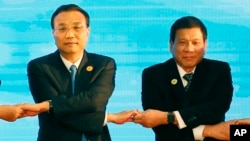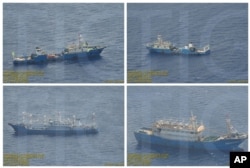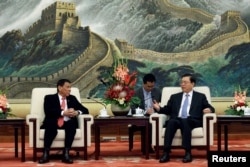A bloc of 10 Southeast Asian nations has a chance to open tough discussions next year on how to handle China’s contested expansion in the South China Sea as the Philippines, one of Beijing’s chief maritime rivals, becomes the organization’s chair with authority to set its 2017 agenda.
President Rodrigo Duterte, who will chair ASEAN for the Philippines, runs a country that got into spats so deep with China since 2012 that his predecessor took Beijing to a world court tribunal and got a ruling against it in July. But Duterte, who took office in June, has sought to make amends with a receptive China.
“The chair of ASEAN has the power to set the agenda. What [the chair] has been used for historically is to cut things out of the agenda, particularly the South China Sea,” said Tim Johnston, Asia program director with the nongovernmental organization International Crisis Group. “And it will be very interesting to see whether the Duterte Administration puts it on the agenda, and I think it will open the door to other claimants to voice their thing.”
Strong ASEAN movement on the South China Sea could prompt China to rethink its activities in waters contested by several bloc members. But inaction would give China confidence and possibly send a stand-down signal to the United States, an informal protector of smaller claimants facing China.
Careful approach
The 50-year-old group of countries comprising a population of about 625 million normally works as a trading bloc and source of economic development cooperation. ASEAN tackles the South China Sea dispute when led by the chair or based on proposals from other members. It has been slowly formulating a South China Sea code of conduct since 2002 to avoid any dangerous mishaps between rival claimants, but Beijing has not been eager to move quickly on the issue.
ASEAN members Brunei, Malaysia and Vietnam make maritime claims that overlap those of Beijing, which says it has rights to about 95 percent of the 3.5 million-square-kilometer (1.4 million-square-mile) South China Sea stretching from Taiwan to Singapore. China periodically passes vessels through contested tracts of water. It has also reclaimed about 3,200 hectares worth of land to enlarge some of the disputed islets and militarized several of them.
Vietnam is frequently outspoken, but Brunei and Malaysia keep quiet due in part to reliance on Chinese trade and investment.
“It’s always been and more so now that [there are] some members who are more tilted toward China than the rest, so I suppose finding that balance or a common stance is where the challenge would be,” said Song Seng Wun, an economist in the private banking unit of CIMB in Singapore.
ASEAN chairs since 2013 have made it priority to unify members or avoid upsetting China, said Jonathan Spangler, director of the South China Sea Think Tank in Taipei. The chair rotates to a new Southeast Asian country every year.
ASEAN unity
Malaysia last year maintained an “ASEAN-centric” approach, he said. Chairs this year from Laos and in 2014 from Myanmar also avoided the maritime disputes due to risks of disunity and upsetting their own ties with Beijing, he added, while Brunei as 2013 chair, took a characteristically “low-profile” stance on the maritime dispute.
“It is likely that the Philippines will advocate a leadership role for ASEAN in managing the South China Sea disputes, but it will not sacrifice ASEAN unity to achieve those aims,” Spangler said. “Only half of the ten-member regional grouping has South China Sea claims, so an iron-fisted ASEAN role is far less likely than one that cautiously balances the interests of all its members. For many countries, their relations with Beijing would be a greater priority.”
Duterte sees “maritime security and cooperation” one of his six thematic priorities for 2017, the Philippine Department of Foreign Affairs said Monday on its website.
But at the East Asia Summit in September the president avoided criticizing China despite prepared remarks that would have brought up the dispute, according to the Asia Foundation, a nonprofit international development organization.
The president, known for harsh language, instead lashed out at the United States over what he saw as hypocrisy over human rights. In October he visited China, which prefers to discuss maritime disputes one-on-one rather than via ASEAN or other groups, and received pledges of $24 billion in aid.
The Philippines had previously pressed ASEAN for “solidarity in the face of Chinese pressure” in the South China Sea, the foundation says.
















